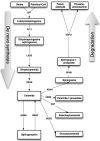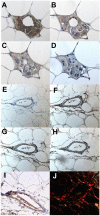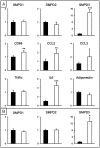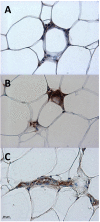Expression of ceramide-metabolising enzymes in subcutaneous and intra-abdominal human adipose tissue
- PMID: 22974251
- PMCID: PMC3478226
- DOI: 10.1186/1476-511X-11-115
Expression of ceramide-metabolising enzymes in subcutaneous and intra-abdominal human adipose tissue
Abstract
Background: Inflammation and increased ceramide concentrations characterise adipose tissue of obese women with high liver fat content compared to equally obese women with normal liver fat content. The present study characterises enzymes involved in ceramide metabolism in subcutaneous and intra-abdominal adipose tissue.
Methods: Pathways leading to increased ceramide concentrations in inflamed versus non-inflamed adipose tissue were investigated by quantifying expression levels of key enzymes involved in ceramide metabolism. Sphingomyelinases (sphingomyelin phosphodiesterases SMPD1-3) were investigated further using immunohistochemistry to establish their location within adipose tissue, and their mRNA expression levels were determined in subcutaneous and intra-abdominal adipose tissue from both non-obese and obese subject.
Results: Gene expression levels of sphingomyelinases, enzymes that hydrolyse sphingomyelin to ceramide, rather than enzymes involved in de novo ceramide synthesis, were higher in inflamed compared to non-inflamed adipose tissue of obese women (with high and normal liver fat contents respectively). Sphingomyelinases were localised to both macrophages and adipocytes, but also to blood vessels and to extracellular regions surrounding vessels within adipose tissue. Expression levels of SMPD3 mRNA correlated significantly with concentrations of different ceramides and sphingomyelins. In both non-obese and obese subjects SMPD3 mRNA levels were higher in the more inflamed intra-abdominal compared to the subcutaneous adipose tissue depot.
Conclusions: Generation of ceramides within adipose tissue as a result of sphingomyelinase action may contribute to inflammation in human adipose tissue.
Figures





Similar articles
-
Ceramide metabolism is affected by obesity and diabetes in human adipose tissue.J Cell Physiol. 2012 Feb;227(2):550-7. doi: 10.1002/jcp.22745. J Cell Physiol. 2012. PMID: 21437908
-
In Human and Mouse Spino-Cerebellar Tissue, Ataxin-2 Expansion Affects Ceramide-Sphingomyelin Metabolism.Int J Mol Sci. 2019 Nov 21;20(23):5854. doi: 10.3390/ijms20235854. Int J Mol Sci. 2019. PMID: 31766565 Free PMC article.
-
Adipose tissue inflammation and increased ceramide content characterize subjects with high liver fat content independent of obesity.Diabetes. 2007 Aug;56(8):1960-8. doi: 10.2337/db07-0111. Epub 2007 Jul 9. Diabetes. 2007. PMID: 17620421
-
Inhibition of sphingomyelin hydrolysis: targeting the lipid mediator ceramide as a key regulator of cellular fate.Curr Med Chem. 2009;16(16):1978-2000. doi: 10.2174/092986709788682182. Curr Med Chem. 2009. PMID: 19519377 Review.
-
Sphingomyelinases and Liver Diseases.Biomolecules. 2020 Oct 30;10(11):1497. doi: 10.3390/biom10111497. Biomolecules. 2020. PMID: 33143193 Free PMC article. Review.
Cited by
-
Sphingolipid metabolism and its relationship with cardiovascular, renal and metabolic diseases.Arch Cardiol Mex. 2023;93(1):88-95. doi: 10.24875/ACM.21000333. Arch Cardiol Mex. 2023. PMID: 36757794 Free PMC article. Review. English.
-
Immunolocalization of Sphingolipid Catabolism Enzymes along the Nephron: Novel Early Urinary Biomarkers of Renal Damage.Int J Mol Sci. 2023 Nov 23;24(23):16633. doi: 10.3390/ijms242316633. Int J Mol Sci. 2023. PMID: 38068956 Free PMC article.
-
Sphingolipids in adipose tissue: What's tipping the scale?Adv Biol Regul. 2018 Dec;70:19-30. doi: 10.1016/j.jbior.2018.10.002. Epub 2018 Oct 15. Adv Biol Regul. 2018. PMID: 30473005 Free PMC article. Review.
-
Sphingolipids in metabolic disease: The good, the bad, and the unknown.Cell Metab. 2021 Jul 6;33(7):1293-1306. doi: 10.1016/j.cmet.2021.06.006. Cell Metab. 2021. PMID: 34233172 Free PMC article. Review.
-
Adiponectin overexpression improves metabolic abnormalities caused by acid ceramidase deficiency but does not prolong lifespan in a mouse model of Farber Disease.Mol Genet Metab Rep. 2024 Apr 3;39:101077. doi: 10.1016/j.ymgmr.2024.101077. eCollection 2024 Jun. Mol Genet Metab Rep. 2024. PMID: 38595987 Free PMC article.
References
-
- Kolak M, Westerbacka J, Velagapudi VR, Wågsäter D, Yetukuri L, Makkonen J, Rissanen A, Hakkinen AM, Lindell M, Bergholm R. et al.Adipose tissue inflammation and increased ceramide content characterize subjects with high liver fat content independent of obesity. Diabetes. 2007;56:1960–1968. doi: 10.2337/db07-0111. - DOI - PubMed
Publication types
MeSH terms
Substances
LinkOut - more resources
Full Text Sources
Other Literature Sources
Medical

